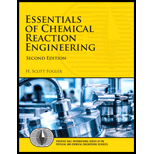
Example 4-1. Would the example be correct if water were considered an inert? Explain.
(a)
Interpretation:
The value of equilibrium constant is to be calculated for a given elementary reversible gas phase reaction in a flow reactor.
Concept Introduction :
The general rate law is represented as follows:
Here,
Also,
The rate law expression becomes equal to zero at equilibrium.
Answer to Problem 4.3Q
The value of equilibrium constant (Kc) is
Explanation of Solution
The elementary reversible reaction which is carried out in a flow reactor is given as
The inlet concentration of A
The equilibrium conversion
The rate expression of the reaction is written as
The equilibrium rate constant (KC) =
The above rate expression can be simplified in terms of the equilibrium constant as
At equilibrium,
Where
Since the reaction takes place in the gas phase, the volume expansion factor
Where
Since the feed is pure A, therefore
The values of
And,
Thus,
Where a and b are stoichiometric coefficient of A and B respectively.
Plugin the values of
(b)
Interpretation:
The value of the equilibrium constant is to be calculated for a given elementary reversible liquid phase reaction in a flow reactor.
Concept Introduction :
The rate law expression becomes equal to zero at equilibrium and for liquid phase reaction, the value of the volume expansion factor becomes equal to zero.
Answer to Problem 4.3Q
The value of equilibrium constant (Kc) is
Explanation of Solution
The expression of equilibrium constant will remain the same which is derived in part a.
For liquid phase reaction volume of the reaction mixture will not change. Therefore, the volume expansion factor becomes equal to zero.
So, the expressions of
Plug in the values of initial concentration and equilibrium conversion in equation (2)
Similarly, for
Plug in the values of initial concentration and equilibrium conversion in equation (3)
Plug in the values of
(c)
Interpretation:
The rate law equation is to be expressed in terms of conversion for a reversible, elementary, gas-phase, isothermal reaction.
Concept Introduction : For an elementary reaction, the rate law equation corresponds to the stoichiometric equation.
Answer to Problem 4.3Q
The rate equation is
Explanation of Solution
For a reaction
The value of rate constant
The value of equilibrium constant
The relationship between
Plug in the values in equation (5)
The values of
Plug in the values of
(d)
Interpretation:
The rate equation is to be expressed in terms of conversion for a constant volume batch reactor.
Concept Introduction: For an elementary reaction, the rate law equation corresponds to the stoichiometric equation and the value of the volume expansion factor becomes equal to zero for a constant volume batch reactor.
Answer to Problem 4.3Q
The rate expression for a constant volume batch reactor is
Explanation of Solution
For constant volume batch reactor, the expressions of
Plug in the values of the initial concentration of A and stoichiometric coefficient in equation (6) and (7)
The values of rate constants will remain the same.
Plug in the values of
Want to see more full solutions like this?
Chapter 4 Solutions
Essentials of Chemical Reaction Engineering (2nd Edition) (Prentice Hall International Series in the Physical and Chemical Engineering Sciences)
 Introduction to Chemical Engineering Thermodynami...Chemical EngineeringISBN:9781259696527Author:J.M. Smith Termodinamica en ingenieria quimica, Hendrick C Van Ness, Michael Abbott, Mark SwihartPublisher:McGraw-Hill Education
Introduction to Chemical Engineering Thermodynami...Chemical EngineeringISBN:9781259696527Author:J.M. Smith Termodinamica en ingenieria quimica, Hendrick C Van Ness, Michael Abbott, Mark SwihartPublisher:McGraw-Hill Education Elementary Principles of Chemical Processes, Bind...Chemical EngineeringISBN:9781118431221Author:Richard M. Felder, Ronald W. Rousseau, Lisa G. BullardPublisher:WILEY
Elementary Principles of Chemical Processes, Bind...Chemical EngineeringISBN:9781118431221Author:Richard M. Felder, Ronald W. Rousseau, Lisa G. BullardPublisher:WILEY Elements of Chemical Reaction Engineering (5th Ed...Chemical EngineeringISBN:9780133887518Author:H. Scott FoglerPublisher:Prentice Hall
Elements of Chemical Reaction Engineering (5th Ed...Chemical EngineeringISBN:9780133887518Author:H. Scott FoglerPublisher:Prentice Hall
 Industrial Plastics: Theory and ApplicationsChemical EngineeringISBN:9781285061238Author:Lokensgard, ErikPublisher:Delmar Cengage Learning
Industrial Plastics: Theory and ApplicationsChemical EngineeringISBN:9781285061238Author:Lokensgard, ErikPublisher:Delmar Cengage Learning Unit Operations of Chemical EngineeringChemical EngineeringISBN:9780072848236Author:Warren McCabe, Julian C. Smith, Peter HarriottPublisher:McGraw-Hill Companies, The
Unit Operations of Chemical EngineeringChemical EngineeringISBN:9780072848236Author:Warren McCabe, Julian C. Smith, Peter HarriottPublisher:McGraw-Hill Companies, The





